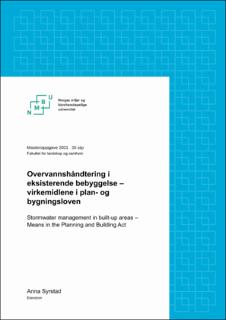| dc.contributor.advisor | Taubøll, Steinar | |
| dc.contributor.author | Syrstad, Anna | |
| dc.date.accessioned | 2021-08-09T11:50:16Z | |
| dc.date.available | 2021-08-09T11:50:16Z | |
| dc.date.issued | 2021 | |
| dc.identifier.uri | https://hdl.handle.net/11250/2767021 | |
| dc.description.abstract | Denne masteroppgaven tar for seg de ulike virkemidlene i plan- og bygningsloven knyttet til overvannshåndtering i eksisterende bebyggelse, samt kommunens håndtering av overvann i byggesaksbehandlingen.
Overvannsproblematikken har økt på grunn av klimaendringene, men og på grunn av befolkningsvekt og fortetting. Utfordringene oppstår i hovedsak i eksisterende bebyggelse, hvor arealeffektiviteten er høy og områdene består av ikke permeable dekker. Ved intense nedbørshendelser oppstår det ofte flom og økt avrenning, som igjen fører til skader på bebyggelse og infrastruktur.
Lokal håndtering av overvann i form av infiltrasjon, fordrøyning eller trygg avledning på overflaten, anses som viktige tiltak for å imøtegå fremtidige problemer knyttet til overvann. Plan- og bygningsloven oppstiller noen virkemiddel som legger til rette for overvannshåndtering, men disse omfatter i stor grad tiltak knyttet til oppgradering av ledningsnettet, som allerede er overbelastet.
Forslag til endring i plan- og bygningslovens gir kommunen økt adgang til å pålegge grunneier tiltak som legger til rette for infiltrasjon og fordrøyning, jf. forslag til ny pbl. § 31-9. Ved bruk av bestemmelsen må det avklares om eiendommen kan håndtere overvannet alene eller ikke. For de eiendommene som ikke kan håndtere overvannet alene, kan et krav om opparbeidelse av privat fellesanlegg for overvannshåndtering pålegges. Bestemmelsen kan benyttes som et vilkår for tillatelse i forbindelse med andre søknadspliktige tiltak, så frem det går fram av plan, er nødvendig, forebygger skade eller ulempe og ikke medfører uforholdsmessige store kostnader.
Forslag til ny pbl. § 31-9 er sett i sammenheng med et konkret case for å belyse kunnskapsgrunnlaget ved etablering av tiltak. Det er ingen fasit på hvilke tiltak som kan iverksettes, eller hva som må tas stilling til i byggesaksbehandlingen. Dette vil i stor grad avhenge av lokale forhold og kommunens skjønn. Hensikten er å synliggjøre kommunens rolle som plan- og bygningsmyndighet i håndteringen av overvann lokalt. | en_US |
| dc.description.abstract | This thesis is based on the means in the Planning and Building Act related to stormwater management in built-up areas, as well as the municipality’s management of stormwater in construction permits.
The stormwater problem has increased due to climate change, population weight, and densification in built-up areas. The challenges arise mainly where the area efficiency is high, and the areas consist of non-permeable covers. The stormwater is mainly led to the draining network that has capacity problems. Due to the limiting capacity, large water volumes could accumulate due to, e.g., heavy rainfalls, which has devastating effects on buildings and infrastructure. Infiltration, diversion, or safe diversion has been considered an important measure to address future problems. The Planning and Building Act has different rules concerning stormwater management, but they are predominantly related to an upgrade of the draining network.
The new proposition in the Planning and Building Act, however, gives the municipality increased access to impose measures regarding infiltration, diversion and safe diversion. The proposition can be used as a part of legislation, but also as a requirement for a building permit. The municipality must inquire whether stormwater can be handled on the property itself. Alternatively, private joint construction plans can be developed. The proposition is necessary to prevent damage or inconvenience, however, an implementation must not lead to disproportionately large costs. The proposition in the Planning and Building Act is seen in the context of a case, to illustrate what knowledge base is required when establishing appropriate measures. The measures that can be implemented, and the knowledge the construction permit is based on will depend on the legislation, local conditions, and the municipality's discretion. There is no clear answer on what measures can be implemented, or what knowledge the construction permit can be based on. This will depend on local conditions and the municipality's discretion.
The thesis intends to shed light on several aspects of the proposal for a new pbl. § 31-9, but also the knowledge base of the construction permit. This is to visibly the municipality's role as planning and building authority in the local management of stormwater. | en_US |
| dc.language.iso | nob | en_US |
| dc.publisher | Norwegian University of Life Sciences, Ås | en_US |
| dc.rights | Attribution-NonCommercial-NoDerivatives 4.0 Internasjonal | * |
| dc.rights | Attribution-NonCommercial-NoDerivatives 4.0 Internasjonal | * |
| dc.rights | Attribution-NonCommercial-NoDerivatives 4.0 Internasjonal | * |
| dc.rights.uri | http://creativecommons.org/licenses/by-nc-nd/4.0/deed.no | * |
| dc.title | Overvannshåndtering i eksisterende bebyggelse : virkemidlene i plan- og bygningsloven | en_US |
| dc.title.alternative | Stormwater management in built-up areas : means in the Planning and Building Act | en_US |
| dc.type | Master thesis | en_US |
| dc.subject.nsi | VDP::Samfunnsvitenskap: 200::Urbanisme og fysisk planlegging: 230::Bebyggelses‑ og reguleringsplanlegging: 234 | en_US |
| dc.description.localcode | M-EIE | en_US |

